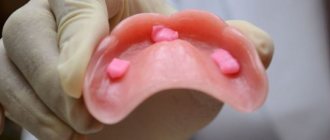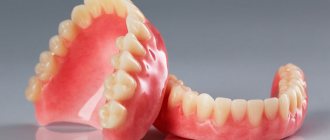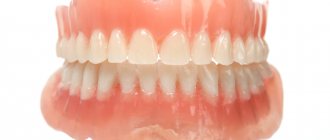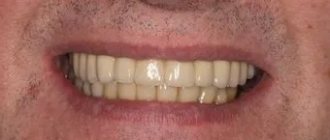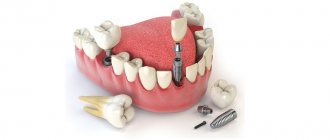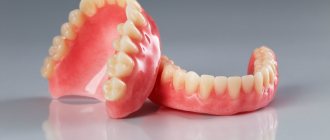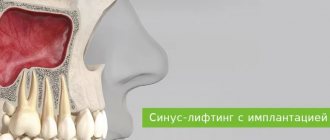News
Anatomical and physiological features of the boundaries of a complete removable denture of the upper jaw
When prosthetizing patients with complete secondary edentia, they are taken into account, which are of great practical importance.
ANATOMICAL AND PHYSIOLOGICAL PREREQUISITES FOR THE CONSTRUCTION OF THE BOUNDARIES OF COMPLETE REMOVABLE DENTURES The vestibule of the oral cavity. The vestibule has the appearance of a narrow horseshoe-shaped gap; on the outside it is limited by the mucous membrane of the lips and cheeks, and on the inside by the labial and buccal surfaces of the alveolar process of the jaw. On the mucous membrane in the vestibule area there are frenulums of the upper and lower lips and bucco-alveolar cords (folds). On the upper jaw there are four buccal-alveolar cords, which are located in the area of the transitional fold at the level of the canines and premolars. More often they are single, less often - multiple. On the lower jaw, the buccal alveolar cords are located in the canine area. As the alveolar processes of the jaws atrophy, the place of attachment of the frenulum changes. With slight atrophy of the jaw bones, the vestibule of the oral cavity has a high arch, the frenulum of the upper and lower lips are located at the base of the alveolar process. The size of the frenulum of the lower lip is, as a rule, somewhat smaller than the frenulum of the upper lip. The frenulum of the upper lip can be shortened and then a gap appears between the central incisors - a diastema. With significant atrophy, the arch of the vestibule flattens, the frenulum extends onto the alveolar process, and with deep atrophy it can be located at the level of the top of the crest of the alveolar process of the jaw. In cases of its high attachment, during contraction of the facial muscles, the frenulum can be stretched and displaced, which leads to the prosthesis being thrown off. To prevent shedding, a recess should be created in the prosthesis. The size of the recess for the lip frenulum should be minimal, that is, strictly correspond to the height and width of the frenulum, in order to avoid injury to it and maintain the continuity of the circular closing valve in this area.
It follows that the most favorable for prosthetics is a high arch of the vestibule of the oral cavity and low attachment of the frenulum. ANATOMIC AND PHYSIOLOGICAL RATIONALE FOR THE BORDERS OF A COMPLETE REMOVABLE DENTURE FOR THE UPPER JAW The shape of the vestibular slope of the alveolar process of the upper jaw.
Depending on the degree of atrophy, three types of vestibular slope of the alveolar process are distinguished:
1) sloping;
2) sheer;
3) with a “canopy”. The most favorable for creating and maintaining a closing valve on the prosthesis during chewing are alveolar processes with a steep vestibular slope, because with small displacements, the edge of the prosthesis slides along the mucous membrane of the alveolar process and fits tightly to it, forming a closing valve, i.e. contacts of the edges of the prosthesis with the slope of the jaw are not disturbed. Less favorable for prosthetics are sloping slopes, in which the prosthesis is freely applied to the jaw, but with small displacements, contact with the mucous membrane is lost. With this shape of the alveolar process, prostheses with expanded boundaries are indicated to achieve and maintain the valve effect. Unfavorable are processes with a “canopy”, in which the base of the prosthesis can injure the mucous membrane due to the presence of bone protrusions on the alveolar processes that appeared after tooth extraction. In addition, in the presence of such processes, it is difficult to create conditions conducive to good suction of the prostheses. Shape of the vault of the hard palate. Depending on the degree of atrophy of the upper jaw, a high, flattened and flat arch of the hard palate is distinguished. A high vault of the palate is most favorable for prosthetics, because it is a point of anatomical retention and limits the movement of the prosthesis in the transversal direction.
Relief of the palatal suture.
The suture of the hard palate is formed by the connection of two bone plates.
He can be:
1) convex due to the bony prominence - the torus, the size and shape of which vary. This form of the palatal suture complicates prosthetics, because when making a prosthesis, the torus must be isolated;
2) smooth - with atrophy of the maxillary bone of class 3 according to the Kurlyandsky classification;
3) concave - most convenient for prosthetics. Incisive papilla. Along the midline of the upper jaw, slightly distal to the apex of the alveolar process, is the incisive papilla. With atrophy of the alveolar process, it may be located directly at the top of the alveolar ridge. The incisive papilla is a prominence of soft tissue covering the incisive foramen from which blood vessels and nerves emerge. When an impression is taken, it is usually compressed. Subsequently, to prevent irritation of the papilla, which can be caused by the pressure of the prosthesis, it is necessary to ensure unloading of the underlying tissues in this area and avoid their displacement during impression taking. In the absence of teeth, the incisive papilla serves as a guide to determine the midline of the model. Transverse palatal folds. In the anterior third of the hard palate, the incisive papilla is bordered by transverse palatal folds - from 3 to 6 on each side. These anatomical structures must be clearly depicted on the cast. Otherwise, they will be pinched and cause pain when using the prosthesis. The maxillary alveolar cusps are located in the distal parts of the alveolar process. They are points of anatomical retention. In case of terminal defects of the dentition and in the complete absence of teeth, the maxillary cusps are always covered by the base of the prosthesis, but in no case should it go further, because Behind the tubercles there are pterygomaxillary folds, which straighten when the mouth is opened strongly, and therefore can throw off removable dentures.
The blind (palatal) fossae are located on the sides of the posterior nasal spine. They represent the fusion of the excretory ducts of the mucous glands, the openings of which are located in close proximity to line “A”. The blind fossae are a convenient reference point for determining the posterior edge of the prosthesis. Structure of tissues of the mucoglandular zone. E.I. Gavrilov introduced the concept of “buffer zones” back in 1962. He noted that the mucous membrane of the hard palate is pliable not only due to the presence of fibrous structures, but also mucous glands and a dense network of blood vessels. The mucous membrane covering the alveolar process and the palatal suture area has minimal buffering properties. As you approach the base of the alveolar process and the soft palate, the buffering properties increase. The tissues of the posterior third of the hard palate have the greatest buffering properties. Line “A” is the boundary between the hard and soft palate. It can be presented as a zone of varying widths. The vibrating zone “A” is the area of the mucous membrane that is detected when pronouncing the sound “A”. The direction of the vibrating zone usually varies according to the shape of the palate: the higher the palatine vault, the more anterior this line is located and the sharper its bend. With a flat palate, the vibrating zone “A” usually extends posteriorly and is characterized by a smooth bend, thus forming its wide posterior edge. Line “A” (vibrating zone “A”) serves as a guide to determine the boundary of the posterior edge of the removable denture: in the absence of teeth, it should overlap it by 1-2 mm. Forms of the soft palate. The degree of possible lengthening of the distal edge of the prosthesis also depends on the shape and magnitude of the inclination of the soft palate in relation to the pharynx. There are three forms of the slope of the soft palate: steep, gentle and average. With a steep, steep palatine slope, the posterior edge of the hard palate corresponds to the place of transition of the fixed mucous membrane into the moving tissues of the soft palate. In such cases, the palatal valve appears as a narrow strip, and the possibility of lengthening the distal edge of the prosthesis is very limited (the prosthesis is then reset, and the patient has a gag reflex). With a gentle slope of the soft palate, the width of the palatine valve can be maximum, which allows the distal border of the prosthesis to be lengthened to improve its fixation. With an average inclination of the soft palate, the width of the palatine valve is of average size.
Some disadvantages
Undesirable consequences that arise while wearing removable dentures almost always develop against the background of problems with the base. Let's look at the most common of them:
- excessive pressure of the base on the underlying tissue;
- damage to bone structures and periosteum;
- loosening of mucous membranes and increasing their permeability;
- violation of thermoregulation in the oral cavity;
- development of gingivitis and cervical caries;
- formation of periodontal pockets;
- damage to tooth enamel (typical of metal bases);
- speech function disorder;
- changes in taste sensations;
- intensive production of pathogenic microorganisms in the oral cavity.
Currently, technologists are trying to eradicate the occurrence of these problems through technical innovations in the production process of orthopedic products for removable prosthetics.
Let's look at existing updates:
- equipping the structure with clasps , which act as supporting elements for all components of the structure;
- reducing the contact area of the plastic base with the recesses between the remaining teeth and gum tissue;
- creation of two-layer elements for sensitive mucous structures , which are able to completely prevent the balancing of the base. Some of these structures are made of plastic with highly elastic properties.
Remember! The parameters of the bases and the material used in their manufacture have fixed standards. Despite this, they can always be corrected, taking into account the complexity of the clinical case and the individual characteristics of the patient.
Possible problems associated with the prosthesis base
A number of negative consequences that usually cause removable dentures relate specifically to the base.
The base often puts pressure on the tissues on which it is located, which is why these tissues begin to atrophy. The bone and periosteum can also be damaged due to the fact that the base transmits chewing pressure to them. The mucous membrane, under the influence of the base, loosens, increases its permeability, and thermoregulation is disrupted.
Often, that part of the base that is adjacent to the gingival margin and necks of the teeth becomes the cause of cervical caries and gingivitis, sometimes even with the formation of a periodontal pocket. And metal bases can damage tooth enamel.
In addition to dental problems, the base can cause a number of other problems. Firstly, because of it, speech functions and taste sensations may be impaired. Secondly, the base material often causes allergies. And thirdly, the inner side of the base often becomes a place for active reproduction of microorganisms.
Prices for removable prosthetics
Approximate cost of services
NamePrice
| Removable nylon denture (1 jaw) | 44000 rub. |
| Removable prosthesis Quattro Ti (quadrotti) - Italy (1 jaw) | 44000 rub. |
| Full or partial removable plate denture (acrylic 1 jaw) | 22000 rub. |
| Full or partial removable acrylic denture with frame | 25300 rub. |
| Complete removable plate denture with locking fixation “Uni” | 31350 rub. |
| Therapeutic mouthguard | 4400 rub. |
| Cleaning the prosthesis | 1800 rub. |
Sources:
- https://zen.yandex.ru/media/id/5a91834cfd96b107992f8de2/5d3a6564ac412400ae85a46a
- https://zubza.ru/bazis-proteza/
- https://www.vash-dentist.ru/protezirovanie/semnyie-p/raznovidnosti-bazisov-zubnyih.html
- https://implant-expert.ru/poleznye-stati/bazis-zubnogo-proteza/
- https://zubovv.ru/protezirovanie/semnyie-p/vidyi-bazisov-i-ih-znachimost.html
- https://studfile.net/preview/3884683/page:3/
- https://stom.32top.ru/stat/529/

